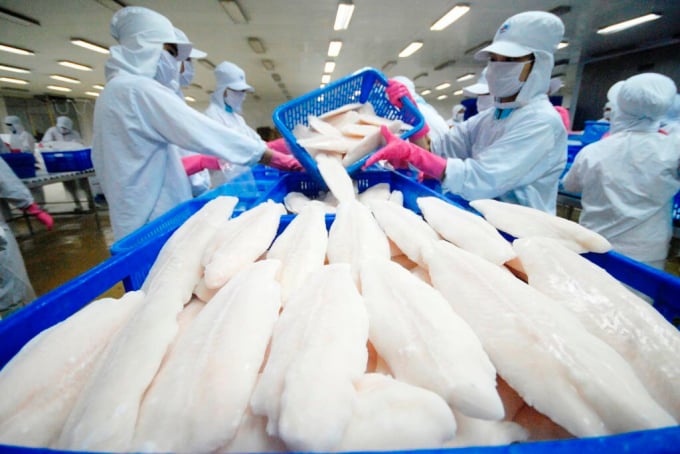November 26, 2025 | 14:57 GMT +7
November 26, 2025 | 14:57 GMT +7
Hotline: 0913.378.918
November 26, 2025 | 14:57 GMT +7
Hotline: 0913.378.918

Tra fish exported to the EU is the product which has the highest using rate of C/O.
To take advantage of tariff preferences in exporting goods to the EU, since last year, Vietnam’s seafood enterprises speed up registering certification of origin (C/O) according to form EUR.1 under the European and Vietnam Free Trade Agreement (EVFTA).
The EU is one of the biggest exporting markets of Vietnam’s seafood in recent years, says the Department of Exports and Imports (under the Ministry of Industry and Trade - MoIT). There is a barrier for exporters as the EU applies pretty high tariff on imported seafood, in the space of 5-20% on raw and preliminary processed seafood and 5.5-26% on processed seafood.
Under the EVFTA, except canned tuna and surimi fish cake are applied quotas by the EU (11.5 thousand tons and 500 tons, respectively), the tariff for other seafood products from Vietnam are eliminated by the EU with the longest schedule is 7 years.
Therefore, the opportunity for Vietnam seafood industry to expand its market in the EU through taking advantage of incentives from the EVFTA Agreement is huge.
In order to enjoy tariff preferences from the EVFTA, Vietnam seafood industry must meet the provisions of the origin of goods under this Agreement and be granted a C/O EUR.1 form under the EVFTA.
Currently, the Ministry of Industry and Trade has authorized 20 agencies and organizations, including 19 regional import - export divisions nationwide and Hai Phong Department of Industry and Trade to grant C/O EUR.1 form.
According to the statistics of the Department of Exports and Imports (MoIT), in the first half of this year, the export value of seafood using C/O EUR.1 form from Vietnam to the EU reached aproximately US$ 336.9 million, accounting for 69.4% of the overall seafood export turnover to the EU (US$ 485.3 million). Of which, raw and preliminary processed seafood account for 34.7%.
The seafood export markets of Vietnam in the EU using C/O EUR.1 form are mainly Germany, Belgium, the Netherlands, Italy and France. These are all major seafood import markets of Vietnam in the EU, with the main imported products being shrimp and tuna.
In the first 6 months of 2021, Germany and the Netherlands are the two seafood import markets of Vietnam with the biggest value on C/O EUR.1 forms issued, respectively reaching US$ 69.4 million and US$ 67.2 million in turnover, and 20.6% and 20% in proportions.
In the same period, aquatic products with high value when using C/O EUR.1 form to export to the EU are: Preliminarily processed shrimp, processed shrimp, frozen fish fillet, frozen squid, processed tuna, processed clams and shellfish. These are all traditional and key export seafood products of Vietnam to the EU market.
Regarding the rate of using C/O EUR.1 form in the total export value of each item, tra fish has the highest rate of using C/O, reaching US$ 50.3 million USD and equivalent for 87% of export turnover of tra fish to the EU (US$ 57.8 million) in the first 6 months of 2021.

Much of shrimp exported to the EU has used the C/O EUR.1 form.
Shrimp is behind tra fish in using C/O EUR.1 form, with export turnover reaches US$ 196.3 million, accounting for 76.9% of overall shrimp export turnover to the EU (US$ 255.2 million).
Although Vietnam's tuna export turnover to the EU has increased in the first 6 months of 2021 (reaching US$ 71.6 million), the rate of using C/O EUR.1 form for this item is still modest, reaching US$ 20 million, and accounting for 27.9% of overall tuna export turnover to the EU.
According to the Vietnam Association of Seafood Exporters and Producers (VASEP), in 2020, Vietnam’s tuna exports to the EU market reached US$ 136 million. The increase was significantly influenced by the EVFTA.
“The rate of using C/O EUR.1 form is a relatively positive outcome of the seafood sector as Vietnam has only begun implementing the EVFTA for nearly a year”, says the Department of Exports and Imports.
“EVFTA is Vietnamese products’ highway to Europe”, recently said Mr. Nguyen Van Thao, the Head of the Vietnam delegation to the EU.
In the first 6 months of 2021, the rate of EVFTA tax incentives for exports being fully utilized is up to 29.09%. Many key agricultural products of Vietnam have experienced significant export growth compared to the same period in 2020.
Translated by Khanh Linh

(VAN) China’s cooking oil is suddenly flooding into India. It all comes down to a soybean surplus that Beijing doesn’t quite know what to do with.

(VAN) An Giang promotes supply-demand connections, standardizes quality and builds value chains, creating a foundation for sustainable bird’s nest development and aiming to expand exports.
/2025/11/24/5339-4-nongnghiep-075331.jpg)
(VAN) Recently, the conference on 'Sustainable Fisheries Linkage Chain - Tilapia for Export' took place in Tien Hai commune, Hung Yen province.
/2025/11/21/4309-2-153400_128.jpg)
(VAN) Green and low-emission rice is paving the way for Vietnamese rice to enter high-end markets, marking the beginning of a transformation journey toward greening and elevating the national rice brand.

(VAN) ‘Right to Win’ outlines a national action plan that shapes a new vision for Viet Nam’s agriculture in an era of renewal and global integration.

(VAN) Lam Dong’s farmed sturgeon output this year is expected to reach 2,300 tons, worth VND 450 billion, affirming the brand’s position on the market.

(VAN) A surge in Ukrainian egg exports, largely driven by soaring sales to the UK over the last few years, has notably pushed up egg prices on the domestic market.